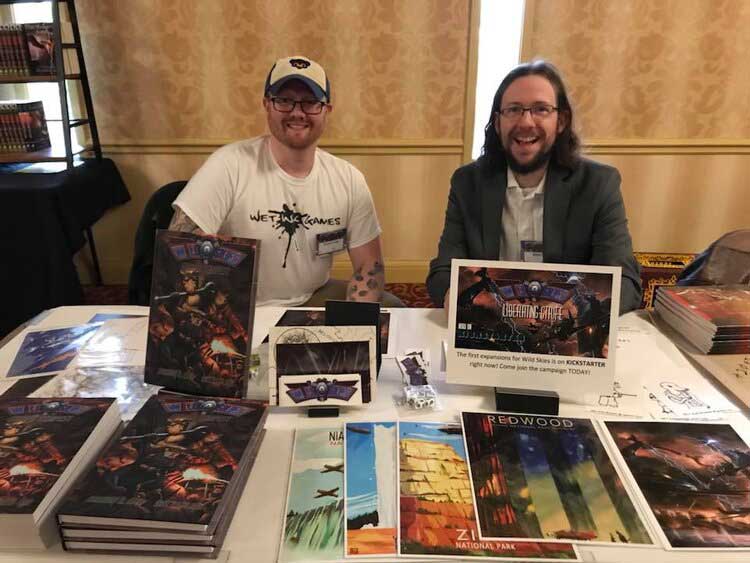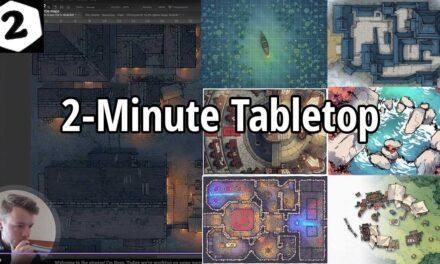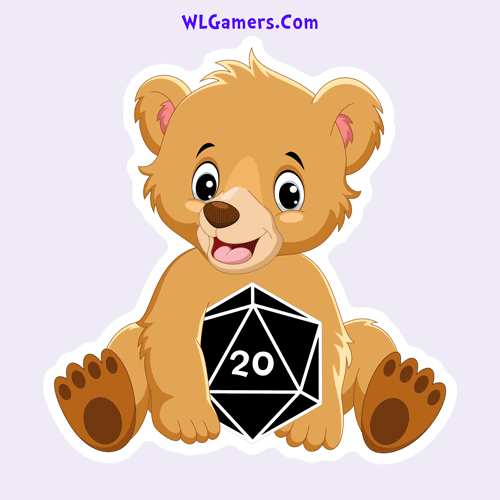A Chat With Wet Ink Games
Game design is a challenging undertaking that takes a lot of hard work, networking, and no small amount of luck. It also takes a love of games. We checked out Wet Ink Games at GenCon and got a chance to talk with them some at NerdLouvia and was very excited that they agree to share with us their story as well as some insight into the gaming industry. Friendship that combines with game crafting is what led to the inception of Wet Ink Games. Read on to learn more.
GeekPost: How did Wet Ink Games get started? Tell us a bit about the history of the company and its founders.
W.I.G.: Wet Ink Games was started, officially, in 2015 when Brandon Aten and I, Matthew Orr, launched our first crowdfunding campaign.
We are both long-term nerds who have been playing roleplaying games together since middle school when I found out Brandon had a roleplaying ,game about Teenage Mutant Ninja Turtles. As we came up in the nerdosphere, we both worked as freelance writers for established companies like Palladium Books and Third Eye Games. As early as 2011 we had an idea which didn’t seem like anyone else would want to publish, plus we wanted to start working for ourselves. Wild Skies is an alternate history version of the 1930s with big, gritty technology like flying battleships and lots of mercenaries, plus everyone is a humanoid animal. That project was funded with a lot of help from our friends and family, but we made enough fans that we’ve been able to keep publishing books. Never Going Home came out in 2019, and that’s our flagship game right now. It was inspired by the art of Charlie Ferguson-Avery and is set during the First World War where “Others” from beyond the Veil have been corrupting the soldiers. There’s evil magic and gross mutations and you play as soldiers who are basically trapped in the horrors of war. Since then, we’ve grown from a writing team into a proper publisher. We’ve worked with industry powerhouses like Banana Chan, Sen-Foong Lim, Doug Levandowski, Bridgett Jeffries and John D. Kennedy. We’ve established ourselves as publishers of horror games, games set in specific historical moments, and we are branching out into “colorful and fun” games like Heckin’ Good Doggos, a game of “dogs doing dog stuff”, which came out this past fall.
GeekPost: What do you feel sets Wet Ink Games apart from other game companies?
W.I.G.: There are two main things we try to do as a company. The first is to pick projects that fill a void we see in the games industry. Wild Skies is a game where pig-men and bird-ladies fly airplanes. Don’t see a lot of those. Never Going Home is a roleplaying game set in WWI. There isn’t that much competition in that arena. Jiangshi: Blood in the Banquet Hall (which we co-published with Game and a Curry Games) is about a Chinese-American family running a restaurant in 1920s Chinatown. There are no other games which tell that story. We want to work in less-explored corners of history, and we want to work with diverse creators because those stories are what is interesting and valuable to us.
The other thing we do as a company is make beautiful products. We value the craft of bookmaking, we love to see art in print, we want to hold a game in our hands and have it feel good and look good. This takes paying for good art and top-notch graphic design. We are happy to pay for quality work from creative people. We like to let the art lead the sales pitch. Whether the art already exists, or if we are commissioning new art, if the art gets us excited, we know it will excite other people. We say, if the cover of a game gets people to pick up the book, it is doing its job. Of course, once someone opens the book, the writing and the game design must seal the deal. This all comes together in the printing process. We print offset print runs instead of print-on-demand books. It’s worth it from our point of view – for all kinds of reasons – to invest in making quality physical products.
GeekPost: Tell us about some of the different games Wet Ink Games has produced.
W.I.G.: Never Going Home is set in a horror version of the First World War. In addition to gas and shells and mud there are cultists, zombies, and things with tentacles. You have a hand of cards, and you can play those cards for in-game bonuses, but they represent your memories so every time you discard, you describe what part of yourself you losing to corruption. The game line has seven books currently with more coming in 2023. The core book along with some dice and playing cards is all you need to play the game. In addition, we have books which add more monsters, more magic, and more Missions. Then we have our Campaign Dossier series. Each focus on a single year of the war and gives some new setting rules and six connected Missions which tell a longer story in a specific theater. Currently we have 1915 at Gallipoli, 1916 on the Russian front, and 1917 in a U-boat. We will soon be adding a 1914 Dossier set in the Balkans and a 1918 book about the American involvement in the war.
Into the Cess and Citadel, published in collaboration with Feral Indie Studios, is fulfilling now so it will be available to the general public very soon. This is the second in a series of system agnostic source books created by Charlie Ferguson-Avery and Alex Coggon. Cess and Citadel gives you everything you need to make and explore a terrifying fantasy city. There are all sorts of monsters from the illuminated archivist to the cobblestone crab. There are rules to build webs of influence between the rival factions of the city. You can go “dungeon delving” in the tower mansions of the nobility or explore the sewers. It is simply stuffed with art by Alex and Charlie. It might be our most gorgeous publication yet.
Heckin’ Good Doggos is a roleplaying game of dogs doing dog stuff. You play as a regular four-legged dog and you pal around your neighborhood with your pack chasing squirrels, negotiating with raccoons, sniffing out what happened to your lost stuffies and other important dog things like that. It’s a very low stakes game. It’s designed to be all ages and very accessible. There isn’t combat as in typical RPGs, instead conflicts can be solved by playing enough cards of the right type – either cutes (hearts), friends (spades), paws (clubs), or teeth (diamonds).
Check Out Actual Game Play of Heckin’ Good Doggos Above
Sarah & Bethany at GenCon 2022 Wet Ink Games Booth
Branden at GenCon 2021 Wet Ink Games Booth
Branden & Justin at Pax U 2022 Wet Ink Games Booth
Follow Wet Ink Games on Social Media
GeekPost: If someone wanted to create a game, what advice would you give them?
W.I.G.: The standard advice Matt gives is to start small so you can finish. You won’t finish every design you begin, but if your first project is a 350-page political thriller RPG with a rondel-based character sheet, you’re not likely to ever finish. One-page games are still games! Visit the website for 200 Word RPG Challenge and see how much you can do with only 200 words. Make a game on your lunch break with cut-up note cards. Once you complete a few small designs, if you still like it you can move on to bigger projects. We always say, “ideas are easy, execution is hard.” If you can execute an idea at any scale, congratulations, now you are a game designer.
If you are looking to go beyond note cards at lunch, it’s good to develop a sense of where in the industry you want to be. Do you want to make community content (read “free”) for games which already exist? Great, write five pages about different fabulous buckets you can find in the world’s most popular roleplaying game and watch the likes on your post roll in. Do you want to make up new rules for dice? Great! You can sell your design to other people who will publish it. Do you want to make a whole game with proper art and layout and publish it? Also, great! There’s always room for more creators in the indie publishing scene. It takes more skills – or at least different skills – at every stage of your development as a designer. Plus, you don’t have to work at only one scale all the time. We still write for other people’s games even though we are also publishers.
Lastly, the games industry is relatively small. It’s so helpful to meet other people. It’s one thing to look at a writing sample. It’s another thing to chat with a person about what excites them. Even a few words at a convention or through an internet community builds a connection that people remember when they think about who they want to work with. Even if I don’t have work for you, I can recommend you to the next person who asks me if I know someone looking to work.
GeekPost: Wet Ink Games has been successful on Kickstarter so far, what advice would you give to someone wanting to Kickstart a new game?
W.I.G.: Our number one piece of advice we give is to ask for enough to make the game you want. A lot of people ask for (for example) $400 when they know they need $4000. Don’t do that. Maybe you’ll reach your goal in one day and maybe you will continue that momentum. But if you are at 500% of your ask, but you still can’t afford the book, you haven’t done yourself any favors. We have found if you are clear about what the money is for and you can show off some of the art you’re buying and the printing you want, and you have a good track record of delivering, you’ll get to the amount you need. We would rather get to 101% on the last day and then make the game like we want it to be, than have that 500% number and still be unhappy with the finished game.
Now, obviously, you must do all your research and planning to come up with your asking price. Have you talked to printing companies to find out how many you need to print to make it worthwhile to print the book at scale? How many backers at the regular level will you need to get to that number? Is that number realistic based on how much of a following you already have? If not, how will you inform those additional people about your project? Is there a premium version for fans and collectors that can help support the cost of the project? How much extra will that cost? Put everything into the budget: art, writing, printing, shipping, advertising, pay yourself a little bit for your own time as well, remember that all crowdfunding platforms take their cut too. That’s your price to take to crowdfunding. If it’s not realistic, you need to make some different plans before you launch. By “different plans” we don’t mean try to negotiate your artists’ prices down! Do some additional pre-promotion or consider changing the size of the print run.
GeekPost: Do you consider yourselves geeks, and what does that mean to you?
W.I.G.: Matt is more comfortable with the term “nerd”. To him, that means someone who is interested in all that pop culture stuff that used to be for “outsiders” – comics, sci-fi movies, fantasy novels, and the like. That’s all so much more mainstream than it used to be, so maybe “nerd” means less than it used to. Nerdy culture is mostly just popular culture now. Geek feels more like a term for anyone obsessed with anything – a deep interest and knowledge. Someone can be a geek about cars or fly fishing or fantasy football or whatever. The only things I really “geek out” about are Tolkien’s lesser-known work and the old Aliens comics – which, to me, are nerdy topics anyway. So, I call myself a nerd.
To Matt’s point, Brandon also considers himself a pretty big nerd. Everything from Board Games, Card Games, RPGs, comics, clutter up various corners of his basement. Learning about how other designers tackle mechanics we’ve all seen before is something that really intrigues me. I love seeing a new take on a pretty standard mechanism and really taking the design to another level. When that clicks with the theme of the game to make a game more immersive, it’s even better.
GeekPost: Your products have fantastic art, what can you tell us about the process of choosing an artist and planning out the art for a TTRPG book?
W.I.G.: Thank you for saying so. As we mentioned, it’s one of our goals as a company. We are friends with artists and love to meet new artists and we always cheer on artists. We like to pair up a writer and an artist who are matched so the game and the look of the game communicate the same thing. Making the match is so much about knowing the artist’s work. Sometimes people have a particular style, sometimes they can work in multiple styles. The more artists you pay attention to, the more opportunities you have to match the perfect pairing.
Sometimes, when you have an idea for a game, you think “this particular artist would be perfect for this game.” We have worked with Mike Mumah and Steven Wu and Charlie Ferguson-Avery frequently over the years. Other times we see art and think “this should be a game!”, then we bring in the writers to give words to the world already in the art. Crystal Mazur and Michele Lee and Corey Capps have been frequent collaborators from that side.
Whichever comes first, the words or the art, we like to have about one illustration for every ten pages. We’ll pick or commission pieces to match the different sections of the game. We want something that illustrates character creation, leveling up, skill use, combat, etc. We also typically have several illustrations for specific antagonists. The cover is also very important because in a lot of ways the cover is the main advertisement for the game. It’s what’s going to be on the shelf – digital or in a store – and what’s going to be on any other media about the game. The cover should convey at a glance what the game is about or what it feels like to play.
GeekPost: What is one thing you want to make sure anyone reading this interview takes away from it?
W.I.G.: We are very proud of the work we have done to make our games and build our company, and there’s been plenty of work to do. However, we haven’t done it alone by any means. All our collaborators mentioned in this interview are part of the success we’ve had so far. In addition to all the people on the credit’s pages of our games, there are many others – literally hundreds – who have backed us through crowdfunding, reviewed our products, run our games or worked our booths at conventions, interviewed us for print or podcasts, or have shared our content online. We are part of the Indie Game Developer Network as well, and we have gotten an enormous amount of business advice through peers in and out of the network. Plus, our incredible families. All of those people are part of how we’ve gotten to this far and we say “thank you” to them all.
The Geek Post would like to thank the crew of Wet Ink Games for taking the time to allow us all to get to know more about their fantastic company. Make sure to take some time to check them out and remember to support small game companies any time you can!





















Recent Comments